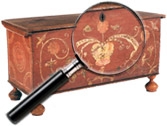John Edward Costigan (American, 1888 to 1972)
John Edward Costigan was a largely self taught artist, working adeptly as a painter and printmaker in various media. He exhibited in over forty shows at the National Academy of Design between 1920 and 1950. He also received critical acclaim in his lifetime-he was named a National Academician in 1928, and was the subject of a traveling retrospective by the Smithsonian American Art Museum in 1968. Unlike some of his contemporaries, such as Everett Shinn and Walt Kuhn, who remained fascinated by the drama and bustle of the Big City for the rest of their careers, Costigan opted for the quiet of the countryside.
In 1919, Costigan married, began a family, and moved to Orangeburg, New York, a suburb just outside of New York City-described by the artist’s son as “the setting for the many idyllic farm landscapes and wood interiors with which he was to become identified.”(1) The farm in Orangeburg would inspire Costigan for the next forty years. His devotion to the pastoral landscape at one point earned him the moniker “Millet of American Painting.”(2) He frequently used his family as the subject of his landscapes, depicting them engaged in the simple pleasures of rural life. His wife Ida May Blessin, a professional model, served as the only model for his female figures, and the children depicted were drawn from his five children and later grandchildren.
(1) Costigan, Daniel M., John Edward Costigan, N.A. American Artist (1888-1972). 24 January 2008. http://www.costigan.net
(2) Watson, Ernest W. “John Costigan: The Millet of American Painting.” American Artist. Oct. 1949: 27.
Information courtesy of Skinner, Inc. March 2008.
